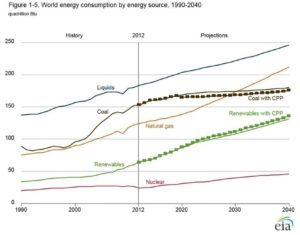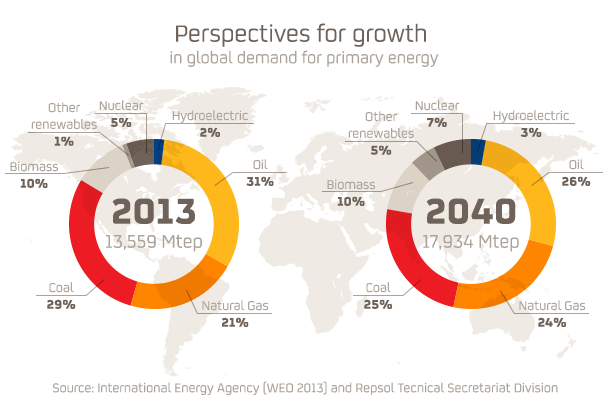The International Energy Outlook 2016 (IEO2016) presents an assessment by the U.S. Energy Information Administration (EIA) of the outlook for international energy markets through 2040. U.S. projections appearing in IEO2016 are consistent with those published in EIA’s Annual Energy Outlook 2015 (AEO2015). IEO2016 is provided as a service to energy managers and analysts, both in government and in the private sector. The projections are used by international agencies, federal and state governments, trade associations, and other planners and decisionmakers. They are published pursuant to the Department of Energy Organization Act of 1977 (Public Law 95-91), Section 205(c).
The IEO2016 energy consumption projections are divided according to Organization for Economic Cooperation and Development members (OECD) [1] and nonmembers (non-OECD). OECD members are divided into three basic country groupings: OECD Americas (United States, Canada, and Mexico/Chile), OECD Europe, and OECD Asia (Japan, South Korea, and Australia/New Zealand). Non-OECD countries are divided into five separate regional subgroups: non-OECD Europe and Eurasia (which includes Russia); non-OECD Asia (which includes China and India); Middle East; Africa; and non-OECD Americas (which includes Brazil). In some instances, the IEO2016 energy production models have different regional aggregations to reflect important production sources (for example, Middle East OPEC is a key region in the projections for liquids production). Complete regional definitions are listed in Appendix M.
IEO2016 focuses exclusively on marketed energy. Nonmarketed energy sources [2], which continue to play an important role in some developing countries, are not included in the estimates. The IEO2016 projections are based on existing U.S. and foreign government laws and regulations. In general, IEO2016 reflects the effects of current policies—often stated through regulations—within the projections. EIA analysts attempt to interpret the likely effects of announced country targets when the implementation of those targets will require new policies that have not been formulated or announced.
The report begins with a review of world trends in energy demand and the major macroeconomic assumptions used in deriving the IEO2016 projections, along with the major sources of uncertainty in the projections, which extend through 2040. In addition to the Reference case projections, High Economic Growth and Low Economic Growth cases were developed to consider the effects of higher and lower growth paths for economic activity than are assumed in the Reference case. IEO2016 also includes a High Oil Price case and, alternatively, a Low Oil Price case. The resulting projections—and the uncertainty associated with international energy projections in general—are discussed in Chapter 1, “World energy demand and economic outlook.” Projections for energy consumption and production by fuel—petroleum and other liquid fuels, natural gas, and coal—are presented in Chapters 2, 3, and 4, along with reviews of the current status of each fuel on a worldwide basis. Chapter 5 discusses the projections for world electricity markets—including nuclear power, hydropower, and other marketed renewable energy resources—and presents projections of world installed generating capacity. Chapter 6 presents a discussion of energy used in the buildings sector (residential and commercial). Chapter 7 provides a discussion of industrial sector energy use. Chapter 8 includes a detailed look at the world’s transportation energy use. Finally, Chapter 9 discusses the outlook for global energy-related carbon dioxide emissions.
Appendix A contains summary tables for the IEO2016 Reference case projections of world energy consumption, GDP, energy consumption by fuel, carbon dioxide emissions, and regional population growth. Summary tables of projections for the High and Low Economic Growth cases are provided in Appendixes B and C, respectively; and projections for the High and Low Oil Price cases are provided in Appendixes D and E, respectively. Reference case projections for delivered energy consumption by end-use sector and region are presented in Appendix F. Appendix G contains summary tables of projections for world petroleum and other liquids production in the three IEO2016 oil price cases. Appendix H contains summary tables of Reference case projections for installed electric power capacity by fuel and regional electricity generation. Appendix I contains summary tables for projections of world natural gas production in the Reference case. Appendix J includes tables of population, per capita economic output, energy intensity of the economy, and carbon intensity of energy. In Appendix K, a set of comparisons of projections from the International Energy Agency’s World Energy Outlook 2015 with the IEO2016 projections is presented. Comparisons of the IEO2016 and IEO2013 projections are also presented in Appendix K. Appendix L describes the models used to generate the IEO2016 projections. Appendix M defines the regional designations included in the report.

Objectives of the IEO2016 projections
The projections in IEO2016 are not statements of what will happen, but what might happen given the specific assumptions and methodologies used for any particular scenario. The Reference case projection is a business-as-usual trend estimate, given known technology and technological and demographic trends. EIA explores the effects of alternative assumptions in other scenarios with different macroeconomic growth rates and world oil prices. The IEO2016 cases generally assume that current laws and regulations are maintained throughout the projections. Thus, the projections provide policy-neutral baselines that can be used to analyze international energy markets.
While energy markets are complex, energy models are simplified representations of energy production and consumption, regulations, and producer and consumer behavior. Projections are highly dependent on the data, methodologies, model structures, and assumptions used in their development. Behavioral characteristics are indicative of real-world tendencies, rather than representations of specific outcomes.
Energy market projections are subject to much uncertainty. Many of the events that shape energy markets are random and cannot be anticipated. In addition, future developments in technologies, demographics, and resources cannot be foreseen with certainty. Key uncertainties in the IEO2016 projections are addressed through alternative cases.
EIA has endeavored to make these projections as objective, reliable, and useful as possible. They are intended to serve as an adjunct to, not a substitute for, a complete and focused analysis of public policy initiatives.

